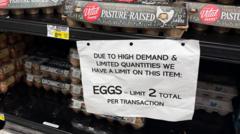The surge in egg prices has put significant pressure on small restaurants across the U.S., prompting owners to seek creative solutions to maintain their businesses amidst rising costs and ongoing supply chain issues.
Restaurants Face Egg Price Crisis Amid Bird Flu Outbreaks

Restaurants Face Egg Price Crisis Amid Bird Flu Outbreaks
As egg prices soar due to avian flu, small eateries are forced to adapt their menus and sourcing strategies to survive.
Like many establishments in the food industry, small eateries are grappling with the ramifications of skyrocketing egg prices. The Square Diner, located in New York City, is particularly affected as eggs constitute 60% of its menu. Citing a devastating impact from recent bird flu outbreaks that resulted in a loss of approximately 15% of the U.S. egg-laying chicken population, restaurant owners are feeling the strain of wholesale egg prices soaring above $8.50 per dozen in February.
The consequences of these rising prices are felt widely. Small business owners may face potential closure as their routine procurement of eggs—an ingredient they often use in large quantities—becomes unsustainable. To adjust, many are opting for inventive methods: altering recipes, utilizing alternatives such as powdered or liquid eggs that don't reflect the same price increases, or even diversifying the menu with items that don't require eggs, like falafel or packaged snacks.
Although prices have slightly tapered off in recent weeks, they are still significantly higher than historical averages, continuing to unsettle restaurant owners. The U.S. Department of Agriculture has forecast that egg prices may see an increase nearing 58% for the year, driven by factors such as the sustained popularity of all-day breakfast options and protein-rich diets that maintain high demand.
The characteristic perishability of eggs compounds the problem. Smaller businesses typically lack the financial buffer required to store eggs in large quantities or to invest in additional refrigeration units. "You can't stockpile a month's supply of eggs," explains Rob Handfield, a supply chain management expert. Instead, small businesses rely on frequent deliveries to meet their needs.
This precarious situation underscores the ongoing challenges faced by mom-and-pop eateries in a landscape increasingly influenced by unstable pricing and supply chains.




















